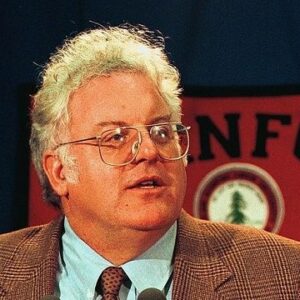Robert B. Laughlin is a physicist from the United States who shared the 1998 Nobel Prize in Physics. He is well-known for his work on plasma and nuclear physics difficulties relating to fusion and nuclear-pumped X-ray lasers. As a theorist, he is interested in a wide variety of subjects, from hard-core engineering to cosmology. As the son of a lawyer and a schoolteacher, he grew up in an intellectually stimulating environment. As a young boy, he acquired an early interest in physics and played with electronic gadgets at home. His passion for experimentation was so strong that he would occasionally conduct potentially dangerous ones, much to the disgust of his parents. He earned a bachelor’s degree in physics from the University of California, Berkeley, and a doctorate in physics from the Massachusetts Institute of Technology. He then joined Bell Labs’ Theory Group on his instructors’ advice and began his fascinating career in research. He developed an interest in semiconductors while working there and began his collaboration with Daniel C. Tsui and Horst L. Störmer, which finally resulted in the explanation of the fractional quantum Hall effect. The trio was awarded the 1998 Nobel Prize in physics for their seminal discovery.
Childhood & Adolescence
Robert Betts Laughlin was born in Visalia, California, the eldest of four children in a middle-class household, on November 1, 1950. His father was an attorney, while his mother was a teacher.
His parents encouraged their children to participate in conversations about current events and political concerns and instilled in them an interest in learning more about the world. Robert was fascinated by science, particularly physics, from an early age.
He used to dismantle and analyze electronic devices, and he also enjoyed conducting science projects at home. He was also drawn to natural sciences and mathematics as a youth, an interest he received from his father.
Following graduation from high school, he enrolled in the University of California, Berkeley, where he was able to attend lectures by Nobel laureates such as Owen Chamberlain and Charles Townes. He also took an introductory course in solid-state physics through the advanced quantum mechanics course taught by Charles Kittel and Geoffrey Chew.
He graduated in 1972 and was drafted into the army shortly thereafter to service in the Vietnam War. He began graduate school at MIT in the fall of 1974 after being discharged from the military after two years. He was quite active throughout his stay at MIT, earning a Ph.D. in physics in 1979.
Robert Laughlin’s Career
He was suggested for a post at Bell Labs’ Theory Group by his professor shortly after obtaining his doctorate. It was an excellent chance for a young physicist. Bell Labs had a reputation as one of the greatest institutions in the United States for solid-state physics research, which gave young scientists enormous opportunities for their research careers.
He was already familiar with semiconductors from his work at MIT on the theory of silicon-oxide interactions. He met and engaged with professionals in the field, including future collaborator Daniel C. Tsui.
He was unable, however, to obtain a permanent position at Bell Labs and transferred to the Lawrence Livermore National Laboratory in Livermore, California, in 1981. Meanwhile, his Bell Labs colleagues Horst L. Störmer and Daniel C. Tsui had been experimenting with the Hall effect and had seen it at temperatures close to absolute zero and in extremely strong magnetic fields.
Tsui and Störmer’s collaborative research produced some perplexing findings. Laughlin was able to propose a theoretical explanation for these perplexing findings in 1983. His discoveries revolutionized the field of quantum physics and finally earned him a share of the Nobel Prize in a few years.
His increasing reputation resulted in job offers from a number of major universities. In 1985, Robert Laughlin was appointed associate professor of physics at Stanford University. In 1989, he was appointed a full professor at Stanford.
He joined Stanford University in 1992 as the Anne T. and Robert M. Bass Professor of Physics and Applied Physics, a position he continues to occupy.
His Significant Works
Robert Laughlin, best known for his work on the quantum Hall effect—a quantum-mechanical version of the Hall effect—discovered the connection between precise quantization and gauge invariance by connecting the quantized conductivity of a Thouless charge pump to the quantized charge transport.
Additionally, he created what is now known as the Laughlin wavefunction, a many-body wave function for the fractional quantum Hall effect that accurately explained the fractionalized charge observed in tests.
Awards and Accomplishments
He has received numerous honors, including the E. O. Lawrence Award for Physics (1985), the Oliver E. Buckley Prize (1986), membership in the National Academy of Sciences (1994), and the Benjamin Franklin Medal for Physics (1994). (1998).
The 1998 Nobel Prize in Physics was jointly awarded to Robert B. Laughlin, Horst L. Störmer, and Daniel C. Tsui “for their discovery of a new type of quantum fluid containing fractionally charged excitations.”
Personal History and Legacies
He met Anita at MIT and later married her. His wife is an educator and author, and the couple is the parents of two grown sons.
Estimated Net worth
Robert B. Laughlin is one of the wealthiest physicists and is included on the list of the most popular physicists. Robert B. Laughlin’s net worth is estimated to be $1.5 million, based on our study of Wikipedia, Forbes, and Business Insider.


